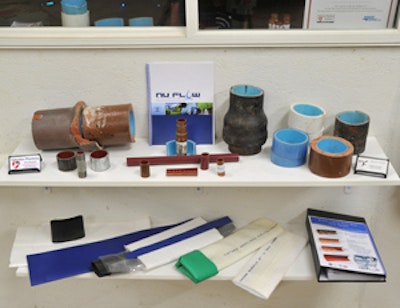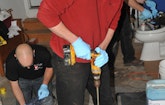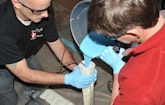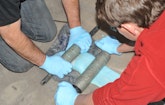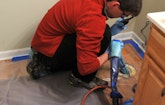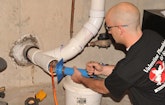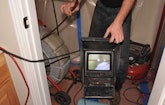
Interested in Waterblasting?
Get Waterblasting articles, news and videos right in your inbox! Sign up now.
Waterblasting + Get AlertsAfter more than 30 years providing basic plumbing services, Valentine Plumbing in Cortland, Ill., was at a crossroads. Owner Bruce Foster, who was also teaching continuing education classes to licensed plumbers and apprentices, had his hands full and the business was on life support. Foster, a licensed inspector for the state, was more or less retired from the service business.
Along came Tom Bowman, a friend and journeyman plumber with an extensive background in sewer repair and several years of lining experience. The two men became partners in Valentine Plumbing & Sewer, LLC, with the focus on offering cured-in-place pipe repair. Bowman became the point man in the revival program. That was in 2009.
“Our growth over these years has been huge,” says Bowman. “Through networking and sharing our knowledge we have been able to expand aggressively in a short period of time. The industry is so small right now as far as pipe lining is concerned, and the number of contractors doing this is minimal. If you look in the telephone book you will find hundreds of plumbers listed, but when you look for someone offering to replace and to be truly trenchless you find just a couple.”
With the focus on trenchless line repair, drain cleaning and jetting is now 70 percent of the business; the balance is basic plumbing. Their customer base is about 35 percent residential, with the remainder in light commercial, including restaurants and hospitals.
“You need to know and understand the technology,” he says. “We like to look ‘outside the box.’ Look at the whole system, especially inside the building because we can reline anything – sewers, drains, chiller lines, hydraulic lines, storm drains, swimming pool lines, fire suppression systems and conduit lines.”
He compares the apprehension over relining to the time when plastic pipe was first introduced, when people said it would never take off. “Now everybody installs PVC,” he says.
Getting it right
Bowman chose the Nu Flow CIPP system when Valentine jumped into the lining business.
“During our training with Nu Flow, which is actually ongoing, we have been taught many different ways to re-establish the inside diameter of the host pipe, with or without water. We have the use of great specialty tools and we can repair it without a single bit of damage to the hardscape, landscape or the property. We knew we had made the right choice.”
Bowman describes one situation where they had a challenge while lining some grease drains at a franchise restaurant. The crew was working at 2 a.m. to avoid conflicts with the restaurant’s normal operations when they ran into trouble. They contacted Nu Flow’s 24-hour tech support hotline and were offered a solution that allowed them to complete the job without any disturbance to the business.
He notes that people in the industry are beginning to understand the CIPP process, but he doesn’t understand why more contractors don’t offer the service because the market is there.
“We promote ourselves as being trenchless, and we will go wherever the job is,” Bowman says. “We’ve gone into Wisconsin to do jobs. We’ve gone to Indiana, Iowa. I hope others get into this. It does not cost a fortune and it pays for itself.”
As for enlightening the customers, Bowman likes to use the analogy of angioplasty and a stent to repair vessels to the human heart, which he says most people are familiar with and understand.
“When we first got started, I had diagrams and photos, but with the human heart analogy, they get it right away,” says Bowman.
The right tools
“Our cameras are our best friends,” he says. “Without a good camera system and being able to see every inch of the pipe and to know where the bends are, or where bad offsets are, you will not have a good outcome. You need to know where to start and where to stop the line.”
The company’s camera systems include a RIDGID SeeSnake Flat Pack, a RIDGID SeeSnake microDrain and a RIDGID SeeSnake Plus, along with a Spartan Tool LLC PROvision 2.0 camera system.
Their Nu Flow van is a 2006 Chevrolet Express 2500 Access cargo van with hydraulic side panels and remote control. Service vans are a 1999 and a 2000 GMC/Isuzu cab-over 14-foot box with pullout ramps.
Their 2008 Vactor 2100 has a positive displacement blower, water pump rated at 4,000 psi/80 gpm, 2,500-gallon water tank and a 15-cubic-yard debris tank.
Drain equipment includes a Spartan 1065 rod machine, a Tulip cutter from Enz USA Inc., and both the Micro and Scorpion cutters from Nu Flow. For hydrojetting they have a Spartan 798 trailer jetter with 4,000 psi/18 gpm, and a Harben Eliminator trailer jetter, 3,000 psi/12 gpm.
A team effort
Around 30 percent of Valentine’s business comes from plumbing contractors who are not offering lining service but have customers who are looking for a trenchless solution. Bowman says they welcome this and promote the idea that while one company is not offering CIPP, they do and will work directly with the customer or act as a subcontractor. The choice is with the primary contractor.
“We are not out to take away customers from someone else,” says Bowman. “Often they will say to us, ‘Just take care of our customer. Do whatever they want.’ Other times the referring company will want a small percentage of the business. On other occasions they may want us to ride along in their service vehicle, and we can do that. Our equipment is not that difficult to transport.”
Bowman says they also look for other networking opportunities. When Andrew Kawalewski, owner of Kawalewski Plumbing in Mittagong, New South Wales, Australia, came to the United States to attend the 2012 Pumper & Cleaner Environmental Expo International in March, he visited Valentine Sewer and they did some lining together, shared ideas and sharpened their skills.
“One of the things we like about CIPP is developing new ideas,” says Bowman. “We like to bring in trainers frequently to keep fresh and on the cutting edge. We have started to do some potable water lining, which is going to be important for us.”
The technicians working for Valentine Plumbing & Sewer are enthused about the technology and the part they play in providing CIPP to their customers. They often take time to share experiences and experiment with the product in order to be better prepared for their part as a member of the team.
All Around Pumping, a company that shares Valentine’s 2,400-square-foot office space, is also part of the team. The company provides additional support when needed.
In instances when Valentine needs to reline a 12-inch or larger line, they will make a referral.
Suited to the needs
Valentine is located near the suburbs of Chicago, where there is a great deal of pipe. “Plenty to go around,” says Bowman. And he says this includes pipe inside the structure that also needs to be addressed. “You might have a 100-foot sewer lateral outside the house, but double or triple inside. There will be root problems outside, but also problems with inside lines.”
Typically they deal with lines from 4 inches up to 10 inches for both cleaning and relining. In situations where a 4-inch line transitions to 6 inches, they can prepare a transitional liner to complete the CIPP job. “The end result will be beautiful,” says Bowman.
Pipes they see are typically cast iron, clay tile, galvanized, PVC and Orangeburg.
“We run into situations where the bottom of a pipe has deteriorated completely, or is full of grease or debris,” says Bowman.
“In the past, if a 4-inch pipe was 3 3/4-inch full of grease we would say, ‘Well I guess we close the facility down and dig up underground and replace.’ Maybe water is not even running in the pipe but into the gravel below. Now we come in, use jetters or other tools that don’t use water in order to open up and re-establish an open diameter and run right through with the relining material. It’s phenomenal – I can’t say enough about it.”
Other situations include carbonic acid that builds up in the soda machine lines at franchise restaurants, especially when they are cast iron. This can deteriorate the pipe, but does not affect a relined pipe.
He gave a scenario where they might have to rely on a more traditional method of repair. “We might run into an outside issue with Orangeburg for the sewer line, and it is completely deteriorated. The inside laminate is just brittle and falling away. There is a need to rip it out and replace.
“On the other hand, we might have times when there is a section of pipe that has deteriorated, but the existing pipe is lined up properly and we can shoot through a blank space and connect properly to the other side of the pipe. We had one instance during the pilot program with the state where we were lining a piece of Orangeburg pipe. It had good shape. It was not oval, which would mean it had lost structural shape. We removed some roots. There were three 8-inch-long, 3- to 4-inch-wide holes in the bottom of the pipe. But we had the sections where there was no pipe at all. We were able to line right through it. I understand they have not had a problem since. That was an extraordinary project. It was about 17 feet deep under a concrete porch, walkway and stairway. It would have been a phenomenal chore to replace conventionally.”
Bowman says the average job is a two-man project. They initially televise, clean and prepare the line, looking for bad offsets and determining where to start and stop the line.
“We have different ways to insert the line,” says Bowman. “Whether it is a process where we pull the system into place where there is not a good cleanout access. If we have great access we can use inversion. Where we have a single point of entry we can use a pushrod system and push the system into place.”
According to Bowman, once preparations have been made, the relining process can often be completed in about two hours, unless the ground is wet or the temperature is cold. If they are not using a hot water or steam cure they might want to leave it overnight.
“The key is knowing what technology to use in each instance, and to be aware of what is good and what is bad in the system. Sometimes it depends on the access.”
And the best part for Bowman is that they rarely have to dig. “I don’t want to put my guys or myself in a 20-foot-deep hole, even with proper shoring and dig protection. Now we can do it above ground and fix it, warranty it, and you have a seamless structure that is not going to have joints that will leak or misalign, or have roots growing in between. It will be one solid piece of pipe running through the whole system.
“It is a fully certified structural material, and can stand alone by itself,” he says.
